I explored how African American women’s assimilation through hair is evolving into a revolution that is defining their ethnic identity by calling for black women to accept their afro-textured hair in its natural state. This change is referred to as the Natural Hair Movement. I will identify how this movement liberates black women, and challenges the perception of straight hair as the standard of beauty and acceptance. The perception of beauty will be analyzed in this context while examining the social conditions that spearheaded this movement.
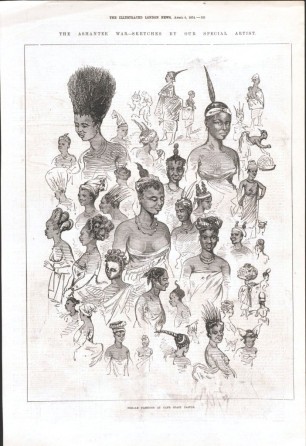
The American Beauty Standard
The definition of beauty varies across history, society and cultures. The beauty of a woman’s hair is defined by the dominant standards of the ruling class. In the United States these standards are Eurocentric, which since the colonial era, has excluded black women. The history of African American hair began in West and Central Africa. In the seventeenth century, Europeans established trade outposts on the West Coast of Africa, whose inhabitants had tightly coiled afro-textured hair, with cultural elaborate hairstyles with adornments. Slavery would begin after African indentured servants were brought to America, in 1619, in Jamestown, and existed as chattel slavery until the passage of the thirteenth Amendment to the U.S. Constitution in 1865, which officially abolished slavery in the United States, after the end of the American Civil War.
Without the tools and herbal creams used in their African homeland for hair care, the culture of grooming African hair could not be retained and therefore their traditional hair care techniques, which are essential for the maintenance of afro-textured hair, began to erode as the slaves no longer had access to the knowledge and herbal treatments needed to care for their hair. In order to treat their hair, slaves relied heavily on cooking scraps from the kitchen such as animal cooking fat, or whatever cleaning household soaps their masters gave them.

The mainstream beauty ideal was exclusively white European, making it all the more unattainable for the slave women. The white society began referring to African hair texture as “wool” and “nappy” which dehumanized the slaves. In some plantations, slave women were commanded to cover their hair with cloth because the appearance of afro-textured hair was considered unpleasant. The hair of a biracial slave was more acceptable, and the overall physical appearance of a biracial slave commanded higher prices at slave auctions than the slaves with darker complexion and tightly coiled afro-textured hair. Color consciousness developed amongst the slave population, thus promoting the idea that loosely curled or straight hair on a woman is more attractive and worth more.
A Solution and the Start of a Revolution
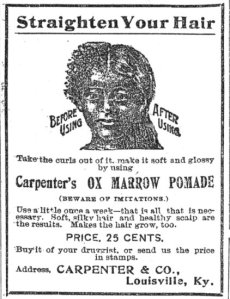
The American social experience throughout history has produced a unique struggle for African American women to create their unique beauty aesthetic. The end of slavery brought about many social and economic changes for black women with the Jim Crow era placing social, political, and economic restraints on black people. Due to the negative perception of afro-textured hair, technology changed the way black women groomed their hair, thus making it easier for black women to assimilate into the mainstream acceptable form of beauty.
The development of the hair relaxer was purely coincidental. The discovery was made by Garrett Morgan, an African-American seamstress who set out to develop a fluid that would provide a useful polish to his sewing needles so as to reduce friction in sewing machines, to prevent it from damaging the fabrics as they sewed.
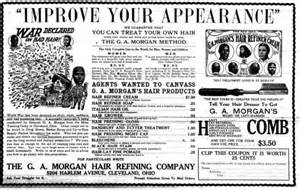
He left some of the fluid he developed on a piece of animal fur cloth and later found it had straightened the fibers of the fur. Intrigued by his discovery, he tried the fluid on his neighbor’s dog which straightened its fur. He then tested it on a small portion of his hair before applying it to his entire head; it straightened all the hair on his head. With a few more experiments, he was successful at developing the first chemical hair straightener for humans. The formula was transformed to create gels and creams, and in 1913, the first chemical hair straightening product was available for public use. This was the beginning of the hair relaxer, sometimes referred to as a “perm,” is designed to chemically alter the natural hair of black women by changing the physical and biological state of the hair, converting it from a tightly coiled state to a straight form. Relaxers became the solution that revolutionized hair beauty for black women in the battle to assimilate into America’s beauty standard to attain social acceptance.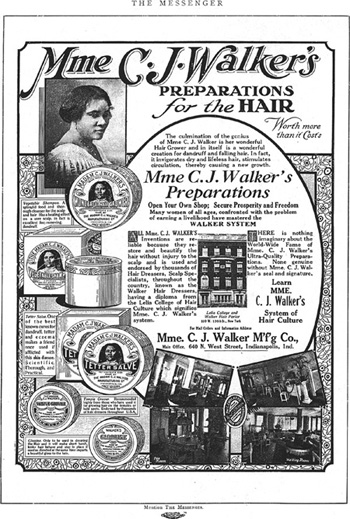
The hot metal comb was an invention that originated from France before it was introduced to the United States. When placed directly on a burner or stove at a high temperature, the comb heats up. When the heated comb is pulled through the hair, the pressure applied during the combing process straightens the hair. This process was used to press and temporarily straighten hair to obtain a smoother texture. Many people have been credited with developing some form of a hair straightening device, but the most influential is Madame C.J. Walker, an African American business woman, who widened the teeth of the hot comb to make it practical for the straightening of afro-textured hair. She also developed a collection of hair product for black women to use along with the hot combs, promoting the proliferation of straight hairstyles among black women. She was revolutionary in training hair professionals in the art of styling black women’s hair, as well as teaching them how to market and distribute the hair products and the grooming tools she created.
In the early 1900s, the hot comb and chemical straighteners were viewed as a blessing to black women’s hair care, and with a growing market its widespread influence was the catalyst for the social changes that black women needed to assimilate into the mainstream white dominated society. Since the Afro-textured hair was viewed as a socially unacceptable hair texture, black women with straight hair were viewed as having “good hair”. This would quickly become a prerequisite for admissions into certain academic programs, public institutions, social clubs, business networks, and the entertainment industry.
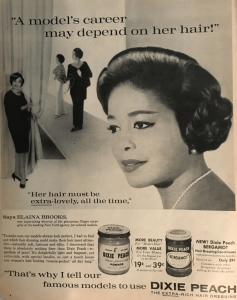
The Birth of a Movement
Since the seventeenth century, black women have engineered tools, creams, and all sorts of hair products, with each claiming to be the “antidote” for a problem, the African American women’s hair. White supremacy points to the straightening of African American women’s hair as a way to fit into the society. The hot combs and other straightening tools became a standard beauty regimen for black women, but it was the relaxer, or the perm, that made the permanent straightening of afro-textured hair a reality. By the 20th century, every beauty shop and hair salon was stocked with tubs of hair relaxers, available to cure the black woman’s hair by ridding her off her natural hair texture. The advent of the 1960s and the Black Power Movement would force reclamation of the natural hair texture of African American women.

Generated out of the Civil Rights Movement, the Black Power Movement awakened racial pride and self-autonomy both politically and socially. In spite of the negative connotations that were associated with the movement at the time, it emphasized the acceptance of the black aesthetics, campaigning against the practice of chemically straightening black women’s hair, while encouraging the exhibition of the afro-texture hair in its unaltered natural state. The afro hairstyle, which was also known as the “natural”, was political as it was part of the movements, promoted by the Black Panther Party. The Afro developed as an outward expression of the burden of assimilation; it was a symbol to free the black woman off the mental shackles of oppression in addition to recapturing their natural African hair texture.
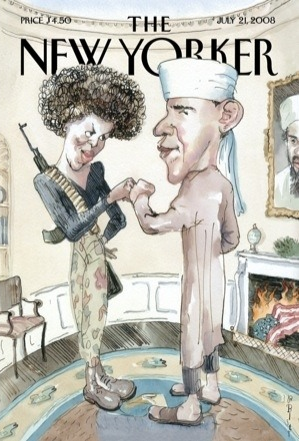
The afro hairstyle became one of the most recognized symbols of the Black Power Movement in the 70s as it places a strong symbol of black identity. However, many people outside of the black community saw it as a threat against the mainstream society. The Afro would come to be perceived as not only taking on a different hairstyle, but adopting a rebellious attitude, specifically the mindset of an angry confrontational black woman who sought to defy the established society. Due to this negative perception of the Afro, its popularity soon declined amongst black women as the “natural” was not acceptable at places of employment and at formal social settings. This form of oppression made African American women to revert back to chemically straightening their hair with relaxers and using heat styling tools such as the hot combs and the flat irons etc, in an effort to look professional so as to be considered for employment, to look desirable, and to gain social acceptance.
Cultural Construction of the Natural Hair

The concept of “good hair,” is the burden of Black women as illustrated in the movie School Daze, and in the comedian and movie maker Chris Rock’s 2009 documentary Good Hair, is a social construction which is deeply rooted in American history. According to Angela M. Neal and Midge L. Wilson, “compared to black males, black females have been more profoundly affected by the prejudicial fallout surrounding issues of skin color, facial features, and hair. This impact can be attributed in large part to the importance of physical attractiveness for all women” (Ashe, BD). The obsession and the pursuit of having “good” hair created a global market for straight human hair thus generating a multimillion dollar enterprise.

Black women of all social classes and economic status continue to put relaxers in their hair and wear long straight hair weaves, attempting to attain the desired form of physical beauty that meets the European standard – the accepted standard of beauty in the United States. Black women have become reliant on hair alteration to the extent of frowning upon their own natural hair texture, and relating it to the physical appearance of a slave, as they socialize their young daughters into the cycle of hair alteration at an age as early as four years old. With time, the African American women began realizing that the European standard of beauty is not suitable for black woman as it not only destroys their self-esteem but was also damaging their scalp.
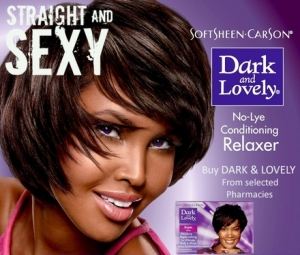
The Rebirth of the Natural Hair Revolution
Black women, in an attempt to mold themselves into a beauty standard that excludes them, have been destroying not just their racial and cultural identity, but also their own skin and hair in the process of using chemical hair straighteners. Black women with natural hair revealed that they are overlooked for promotions at their places of work or are passed on at job interviews, and some children faced discrimination in their schools at the hands of the administration because of the dominant society’s perception of afro-textured hair. One example is the case of Vanessa VanDyke, a 12-year-old girl in Florida, who was threatened with expulsion from school for refusing to cut her natural afro hair.
Many Black women have had enough of the oppressive forced assimilation through hair with a definition of desirability that excludes them, and decided to free themselves from the constraints of assimilating. Consequently, they began to seek an alternative to the white society cultural ideal of beauty. This pursuit gave birth to the Natural Hair Movement—in which groups of African American women opt out of the chemical hair treatments and the dependency of wearing long straight hair weaves. This was a journey

that many black women could not embark on alone, for it is difficult to enter into new territories that society frowns upon, especially an unfamiliar territory such as one that requires re-growing a hair texture that was rejected due to a lifetime of engendered self-hate. It is a journey of self-discovery, and with this, African American women created support groups to encourage and campaign for each other. The new push for embracing the black aesthetics had no political agenda and is not orchestrated by an organization that has a social and political agenda. Instead, individual women across the country began transitioning into their natural hair on their own accord and for their own personal reasons.
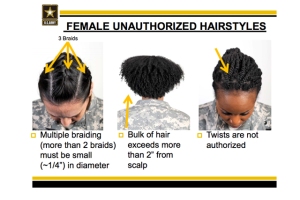
The Black woman’s oppression persists because of her African aesthetic and the natural hair movement sought to fight that oppression. With the influence of social media, the natural hair movement slowly swept across the country within a few years calling for Black women to embrace their true beauty. I had the pleasure of attending natural hair socials which were organized at meetup.com and on other social media outlets by groups of naturalistas, as natural hair women often refer to themselves. It was a phenomenal experience for me, because I would walk into a room filled with women who are unconsciously defying society by embracing the natural state of their hair. The goal of the natural hair socials is for black women with similar cultural identities, and racial pride, to meet other women like themselves in their local areas, to share their experiences as naturalistas, network, and gain exposure to a variety of natural haircare products, and techniques, and to meet other black women that can serve as inspirations for the individual’s natural hair journey. Natural hair socials is a learning experience for the black woman, it is also educational as the open dialogue that developed with the women in attendance cultivated my understanding of America’s forced assimilation through hair on black women.
When asked why they choose “going natural,” as the phrase is placed, many black women expressed that they decided to put an end to using chemical straighteners such as the relaxers because their scalps were reacting to the chemicals, resulting in burning of the scalp. Others were merely following what they regarded a trend, and some said they are learning about themselves, and others said they were tired of trying to gain acceptance into the ideal American standard of beauty. Every response was different from the other; this is evidence that the natural hair movement is a collective of personal experiences. Some black women revealed that they couldn’t remember what their natural hair texture was like, others said the heat styling was damaging to the health of their hair as it increased hair breakage.
The Black woman’s oppression not only comes from white supremacy, it also comes from African American men who hold certain expectations that align with how African American women view their hair. It would be false to only claim that women style their hair for their own happiness, when the laws of attractions dictate that both men and women want to be desired by the opposite sex; therefore they make the necessary efforts to appear desirable. The question many beg to answer is whether African American men subscribe to the white supremacy standard of beauty? Many Black women that I encountered in natural hair socials believe that with time the American beauty standard will be redefined and everyone will change their perception of beauty.

The natural hair movement encourages the versatility of hair grooming and traditional African hairstyles such as the braids, cornrows, dreadlocks, afro curls and many more. African American women whom I spoke to would frequently express the perks of having natural hair such as not being afraid of the rain or going swimming, which produces a negative styling effect on their former relaxed hair. Other perks includes having fun with different creative sculptural hairstyles and getting compliments from strangers, having a healthy scalp restored from chemical burns caused by the relaxers, having a pleasant casual conversation with other naturalistas on hair care techniques and do-it-yourself homemade haircare products, and most importantly developing racial consciousness that gives them a sense of freedom and empowerment to redefine society’s standard of beauty.
When it comes to the economics of Afro-textured hair, the natural hair movement led the development of several hair and skin care companies, owned by African America women fueled by a desire to keep their hair looking good. The natural hair movement is educational as it places a strong emphasis on African heritage and teaches Black women about the nature of their hair by creating a sisterhood amongst black women to encourages them to define their own standard of beauty.
The Black Power Movement of the 60s and 70s paved the way for the natural hair movement, cultivating the spirit of racial pride and cultural identity. This ideology lived on and transferred to subsequent generations shaping the views of the natural hair movement. Though the natural hair movement is not primarily concerned with making a statement; rather it focuses on embracing a defined racial identity of a Black woman to liberating the Black woman. It promotes self-love, femininity, interactions amongst Black women, and entrepreneurship. It welcomes an open dialogue on social problems that aligns with racial identity and comes up with solutions on how to combat those issues, and it forces society to recognize the Black woman’s beauty, and it seizes the opportunity to bring such topics into a mainstream conversation.
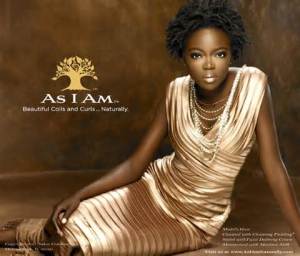
The natural hair movement has gained momentum in Black communities, and the mainstream society is starting to slowly accept it and thereby afro-textured hair no longer has the negative dehumanizing description it once did, thus women who choose to wear their hair in its natural state are no longer being perceived as a menace to society. This change is not meant to imply that we are in a post-racial society, where the European standard of beauty is not the dominant standard but it demands that beauty is based on a diverse racial identity.
This is a really insightful, well written post and I’m really glad I took the time to read it today. I felt like I learned something, from which I have been completely sheltered from for my entire life as a white woman with fine, blonde hair. The idea that natural hair could be deemed unacceptable is absolutely disgusting and I hope that the beauty industry shakes out of this ‘white ideal’ image. Thank you so much for writing this.
LikeLike
Thank you for taking the time to read my post, I appreciate your comment 😀
LikeLiked by 1 person
Great well researched post. Thanks for taking the time to write it and thanks for the education.
LikeLiked by 1 person
Thanks for your comments, I appreciate you stopping by.
LikeLike